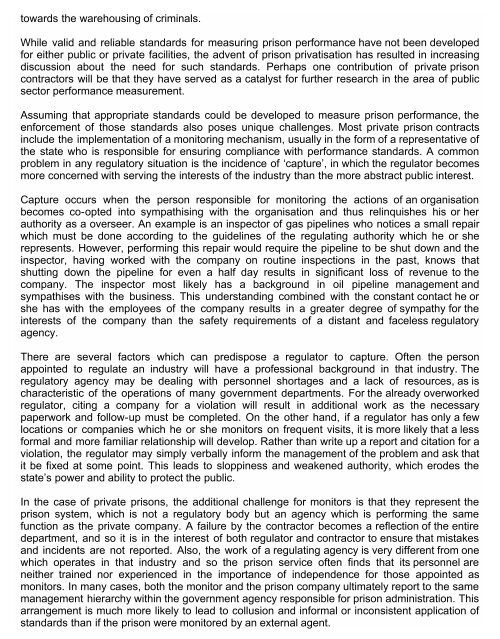prison privatisation in south africa issues, challenges and ...
prison privatisation in south africa issues, challenges and ...
prison privatisation in south africa issues, challenges and ...
You also want an ePaper? Increase the reach of your titles
YUMPU automatically turns print PDFs into web optimized ePapers that Google loves.
towards the warehous<strong>in</strong>g of crim<strong>in</strong>als.<br />
While valid <strong>and</strong> reliable st<strong>and</strong>ards for measur<strong>in</strong>g <strong>prison</strong> performance have not been developed<br />
for either public or private facilities, the advent of <strong>prison</strong> <strong>privatisation</strong> has resulted <strong>in</strong> <strong>in</strong>creas<strong>in</strong>g<br />
discussion about the need for such st<strong>and</strong>ards. Perhaps one contribution of private <strong>prison</strong><br />
contractors will be that they have served as a catalyst for further research <strong>in</strong> the area of public<br />
sector performance measurement.<br />
Assum<strong>in</strong>g that appropriate st<strong>and</strong>ards could be developed to measure <strong>prison</strong> performance, the<br />
enforcement of those st<strong>and</strong>ards also poses unique <strong>challenges</strong>. Most private <strong>prison</strong> contracts<br />
<strong>in</strong>clude the implementation of a monitor<strong>in</strong>g mechanism, usually <strong>in</strong> the form of a representative of<br />
the state who is responsible for ensur<strong>in</strong>g compliance with performance st<strong>and</strong>ards. A common<br />
problem <strong>in</strong> any regulatory situation is the <strong>in</strong>cidence of ‘capture’, <strong>in</strong> which the regulator becomes<br />
more concerned with serv<strong>in</strong>g the <strong>in</strong>terests of the <strong>in</strong>dustry than the more abstract public <strong>in</strong>terest.<br />
Capture occurs when the person responsible for monitor<strong>in</strong>g the actions of an organisation<br />
becomes co-opted <strong>in</strong>to sympathis<strong>in</strong>g with the organisation <strong>and</strong> thus rel<strong>in</strong>quishes his or her<br />
authority as a overseer. An example is an <strong>in</strong>spector of gas pipel<strong>in</strong>es who notices a small repair<br />
which must be done accord<strong>in</strong>g to the guidel<strong>in</strong>es of the regulat<strong>in</strong>g authority which he or she<br />
represents. However, perform<strong>in</strong>g this repair would require the pipel<strong>in</strong>e to be shut down <strong>and</strong> the<br />
<strong>in</strong>spector, hav<strong>in</strong>g worked with the company on rout<strong>in</strong>e <strong>in</strong>spections <strong>in</strong> the past, knows that<br />
shutt<strong>in</strong>g down the pipel<strong>in</strong>e for even a half day results <strong>in</strong> significant loss of revenue to the<br />
company. The <strong>in</strong>spector most likely has a background <strong>in</strong> oil pipel<strong>in</strong>e management <strong>and</strong><br />
sympathises with the bus<strong>in</strong>ess. This underst<strong>and</strong><strong>in</strong>g comb<strong>in</strong>ed with the constant contact he or<br />
she has with the employees of the company results <strong>in</strong> a greater degree of sympathy for the<br />
<strong>in</strong>terests of the company than the safety requirements of a distant <strong>and</strong> faceless regulatory<br />
agency.<br />
There are several factors which can predispose a regulator to capture. Often the person<br />
appo<strong>in</strong>ted to regulate an <strong>in</strong>dustry will have a professional background <strong>in</strong> that <strong>in</strong>dustry. The<br />
regulatory agency may be deal<strong>in</strong>g with personnel shortages <strong>and</strong> a lack of resources, as is<br />
characteristic of the operations of many government departments. For the already overworked<br />
regulator, cit<strong>in</strong>g a company for a violation will result <strong>in</strong> additional work as the necessary<br />
paperwork <strong>and</strong> follow-up must be completed. On the other h<strong>and</strong>, if a regulator has only a few<br />
locations or companies which he or she monitors on frequent visits, it is more likely that a less<br />
formal <strong>and</strong> more familiar relationship will develop. Rather than write up a report <strong>and</strong> citation for a<br />
violation, the regulator may simply verbally <strong>in</strong>form the management of the problem <strong>and</strong> ask that<br />
it be fixed at some po<strong>in</strong>t. This leads to slopp<strong>in</strong>ess <strong>and</strong> weakened authority, which erodes the<br />
state’s power <strong>and</strong> ability to protect the public.<br />
In the case of private <strong>prison</strong>s, the additional challenge for monitors is that they represent the<br />
<strong>prison</strong> system, which is not a regulatory body but an agency which is perform<strong>in</strong>g the same<br />
function as the private company. A failure by the contractor becomes a reflection of the entire<br />
department, <strong>and</strong> so it is <strong>in</strong> the <strong>in</strong>terest of both regulator <strong>and</strong> contractor to ensure that mistakes<br />
<strong>and</strong> <strong>in</strong>cidents are not reported. Also, the work of a regulat<strong>in</strong>g agency is very different from one<br />
which operates <strong>in</strong> that <strong>in</strong>dustry <strong>and</strong> so the <strong>prison</strong> service often f<strong>in</strong>ds that its personnel are<br />
neither tra<strong>in</strong>ed nor experienced <strong>in</strong> the importance of <strong>in</strong>dependence for those appo<strong>in</strong>ted as<br />
monitors. In many cases, both the monitor <strong>and</strong> the <strong>prison</strong> company ultimately report to the same<br />
management hierarchy with<strong>in</strong> the government agency responsible for <strong>prison</strong> adm<strong>in</strong>istration. This<br />
arrangement is much more likely to lead to collusion <strong>and</strong> <strong>in</strong>formal or <strong>in</strong>consistent application of<br />
st<strong>and</strong>ards than if the <strong>prison</strong> were monitored by an external agent.
















